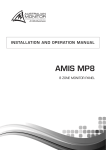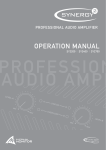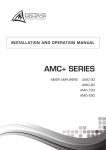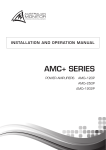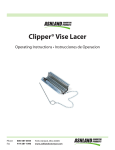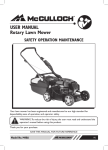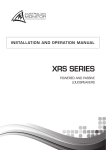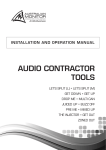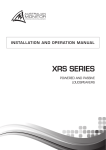Download AUSTRALIAN MONITOR AM2200NG Specifications
Transcript
INSTALLATION AND OPERATION MANUAL AMNG SERIES Audio Power Amplifiers AM2200NG AM2600NG IMPORTANT SAFETY INFORMATION PRÉCAUTIONS DURANT UTILISATION 1. Read these instructions. 1. LISEZ ces instructions. 2. Keep these instructions. 2. Tenez ces instructions. 3. Heed all warnings. 3. Notez tous les avertissements. 4. Follow all instructions. 4. Suivez toutes les avertissements. 5. Do not use this apparatus near water. 5. N’utilisez pas ce produit près de l’eau (la piscine, la plage, le lac, etc.). 6. Clean only with dry cloth. 6. Nettoyez seulement avec une étoffe sèche. 7. Do not block any ventilation openings. Install in accordance with the manufacturer’s instructions. 7. Ne bloquez aucuns troux de ventilation. Installez en accord avec les instructions du manufacturier. 8. Do not install near any heat sources such as radiators, heat registers, stoves, or other apparatus (including amplifiers) that produce heat. 8. N’installez près aucunes sources de chaleur comme radiateurs, registres de chaleur, fours ou les autres équipements (y compris amplificateurs) qui produisent la chaleur. 9. Do not defeat the safety purpose of the polarized or grounding-type plug. A polarized plug has two blades with one wider than the other. A grounding type plug has two blades and a third grounding prong. The wide blade or the third prong are provided for your safety. If the provided plug does not fit into your outlet, consult an electrician for replacement of the obsolete outlet. 10. Protect the power cord from being walked on or pinched particularly at plugs, convenience receptacles, and the point where they exit from the apparatus. 11. Only use attachments/accessories specified by the manufacturer. 12. Use only with the cart, stand, tripod, bracket, or table specified by the manufacturer, or sold with the apparatus. When a cart is used, use caution when moving the cart/apparatus combination to avoid injury from tip-over. 13. Unplug this apparatus during lightning storms or when unused for long periods of time. 14. Refer all servicing to qualified service personnel. Servicing is required when the apparatus has been damaged in any way, such as power-supply cord or plug is damaged, liquid has been spilled or objects have fallen into the apparatus, the apparatus has been exposed to rain or moisture, does not operate normally, or has been dropped. 15. This appliance shall not be exposed to dripping or splashing water and that no object filled with liquid such as vases shall be placed on the apparatus. 16. Plug this apparatus to the proper wall outlet and make the plug to be disconnected readily operable. 17. Mains plug is used as disconnected device and it should remain readily operable during intended use. In order to disconnect the apparatus from the mains completely, the mains plug should be disconnected from the mains socket outlet completely. 18. WARNING: To reduce the risk of fire or electric shock, do not expose this apparatus to rain or moisture. 19. An appliance with a protective earth terminal should be connected to a mains outlet with a protective earth connection. 20. The apparatus should be disconnected from the mains completely before speaker wiring. The speaker output should be proper protected from direct contact and pay attention to speaker connections, terminals and speaker wiring during normal operation. 9. Ne défaites pas le but de sécurité de la fiche polarisée ou base-type. Une fiche polarisée a deux tranchants avec un plus large que l’autre. Une fiche de base type a deux a deux tranchants et une troisième pointe de base, le tranchant large ou la troisième pointe est fourni pour votre sécurité. Si la fiche donnée ne conforme pas votre prise de contact, consultez un électricien pour remplacement de la prise de contact obsolète. 10. Protegez le cordon de secteur contre être marchée dessus ou pincez en particulier aux fiches, aux douilles de convenance, et au point où ils sortent de l’appareil. 11. Seulement utilisez attachements/accessoires spécifiés par le manufacturier. 12. Utilisez seulement avec un chariot, un stand, un trépied, un support ou une table indiquée par le manufacturier, ou vendue avec l’appareil. Quand un chariot est utilisé, faites attention en déplaçant la combinaison d’appareil/chariot pour éviter de se déséquilibrer. 13. Arrachez la fiche du dispositif durant éclair et orage ou quand pas utilisé pour longues périodes de temps. 14. Référez au personnel qualifié de service pour toutes réparations. La réparation est donnée quand le système a été endommagé à n’importe façon, par exemple un fil ou une fiche endommagé(e) de la source d’alimentation. Avoir été exposé à pluie ou humidité, n’opère pas normalement, ou avoir été tombé. 15. L’appareil ne doit pas être exposé aux écoulements ou aux éclaboussures et aucun objet ne contenant de liquide, tel qu’un vase, ne doit être placé sur l’objet. 16. Branchez l’appareil à une source appropriée et faire que la prise à débrancher soit facilement accessible. 17. La prise du secteur ne doit pas être obstruée ou doit être facilement accessible pendant son utilisation. Pour être complètement déconnecté de l’alimentation d’entrée, la prise doit être débranchée du secteur. 18. AVERTISSEMENT: Pour éviter le risque d’incendie ou de chocs électriques, ne pas exposer cet appareil à la pluie ou à l’humidité. 19. Un appareil avec la borne de terre de protection doit être connecté au secteur avec la connexiion de terre de protection. 20. Assurez-vous que l’appareil est hors tension avant de connecter les hauts parleurs. Verifiez que la sortie des enceintes soit protégées contre un contact physique. Respecter les polarités des terminaux ainsi que le câblage des enceintes pendant le fonctionnement afin d’assurer une utilisation sécurisee. INTRODUCTION AND CONTENTS AMNG SERIES INTRODUCTION3 Congratulations on choosing Australian Monitor for your professional amplification requirements. FEATURES4 The AMNG Series Audio Power Amplifiers embrace all aspects of a professional tool exhibiting quality, reliability and longevity. The visual appearance, mechanical, electrical and sonic parameters have been optimized using our dedicated manufacturing process. CONTROLS, CONNECTORS & INDICATORS 5–6 INSTALLATION7–8 OPERATION9 The AMNG Series amplifiers are “2RU (3.5” or 88mm) high, 19” (482mm) wide” rack mountable units. MAINTENANCE10 Each channel of the amplifier comprises a balanced active input with buffered attenuation through to the drive stage in turn feeding a fan-cooled output stage. The amplifier operates from a high current-capable switch-mode power supply. SPECIFICATIONS11 These amplifiers have been specifically designed to deliver their high power output with minimal distortion, and provide the critical degree of control required by your speakers at high duty cycles for extended periods. Revision 1.3 June 2011 WARNING! TO PREVENT FIRE OR SHOCK HAZARD, DO NOT USE THE PLUG WITH AN EXTENSION CORD, RECEPTACLE OR OTHER OUTLET UNLESS THE BLADES CAN BE FULLY INSERTED TO PREVENT BLADE EXPOSURE. TO REDUCE THE RISK OF FIRE OR ELECTRIC SHOCK, DO NOT EXPOSE THIS APPLIANCE TO RAIN OR MOISTURE. TO PREVENT ELECTRICAL SHOCK, MATCH WIDE BLADE PLUG TO WIDE SLOT, FULLY INSERT. CAUTION RISK OF ELECTRIC SHOCK DO NOT OPEN The lightning flash with arrowhead symbol, within an equilateral triangle, is intended to alert the user to the presence of uninsulated “dangerous voltage” within the product’s enclosure that may be of sufficient magnitude to constitute a risk of electric shock to persons. WARNING: TO REDUCE THE RISK OF ELECTRIC SHOCK, DO NOT REMOVE COVER (OR BACK). NO USER SERVICEABLE PARTS INSIDE. REFER SERVICING TO QUALIFIED SERVICE PERSONNEL. The exclamation point within an equilateral triangle is intended to alert the user to the presence of important operating and maintenance (servicing) instructions in the literature accompanying the appliance. Rating plate and caution marking are marked on the back enclosure of the apparatus AM2200NG & AM2600NG INSTALLATION AND OPERATION MANUAL PAGE 3 FEATURES & PROTECTION FEATURES FEATURES Custom designed, 2RU heavy duty steel chassis Built in limiter circuit Front carry handles Stereo, bridged or parallel operation Symmetrical layout – even-weight distribution Binding post and 4 pole speaker output connection Class G operation VU meter High efficiency switch mode power supply Output clip indication Efficient front to back cooling Multi-role output fault indication Variable speed axial fans High-quality, close-tolerance components throughout Balanced inputs and buffered attenuators Lightweight Input signal strapping (loop through) connectors Signal ground lift switch PROTECTION FEATURES Suppression of inrush current at mains turn-on Input muting at turn-on Input overvoltage protection Radio-frequency interference suppression Short-circuit protection and indication High overload mains breaker Thermal sensing PAGE 4 AM2200NG & AM2600NG INSTALLATION AND OPERATION MANUAL CONTROLS, CONNECTORS & INDICATORS 8 6 5 1 7 3 FRONT PANEL The AMNG Series differ only slightly across all models and all share the same features on their front panels. The functions of the controls and indicators are as follows: 1 Power Switch Press the switch to up for power on and down for power off. At start-up (turn-on), the input to the amplifier is muted for approximately two seconds. 2 Australian Monitor Logo/On Indicator The Australian Monitor logo will illuminate and indicates that the amplifier is on and receiving mains power. 3 Fault Indicator This red LED indicates a problem with the amplifier or that it has over heated. In the advent of a thermal overload, the internal operating temperature of one or both amplifier channels has exceeded a safe level of operation and the channels will be automatically muted. The fans will continue to run and once the affected channel/s have cooled, they will unmute and return to normal operation. 2 4 6 Clip This red LED will illuminate when clip occurs. Clipping can occur under extreme operating conditions such as: complex or very low loads over driving the amplifier It should be noted that the minimum load for the amplifier is 2 ohms per channel (4 ohm bridged). NOTE: The amplifier is not damaged by running into clipping, but speakers may be. To maximise the life of your speakers, try to keep clipping infrequent. The clip detection circuit works by using the feedback circuit where the input is continually compared to the output. When the input differs from the output either due to rail clipping or current limiting the clip circuit is triggered. This point also controls the voltage limiter so the voltage will limit at precisely the clip point no matter what the load is or where the mains voltage level is. 7 Bridge Indicator This amber LED will illuminate when the input switch is set to bridge. 8 Fan Grill 4 Attenuator Level control for your amplifier is provided by a potentiometer on the front panel and indicates gain. There are two controls on all AMNG models. Each control is labelled for the channel which it operates. 5 VU Meter This is where air is drawn into the amplifier for cooling. NOTE: You should always ensure that the fan Gril is kept clean and free from the build up of dust and lint. This will ensure longer operation of your amplifier and reduce the possibility of it prematurely going into thermal shutdown mode. See the section “Installation – Cooling” on page 7 for recommended cooling procedures. This is a blue LED lamp which displays the level of the output stage signal. The attack and decay time (ballistics), of the status circuit are those of a Peak Programme Meter (P.P.M.) AM2200NG & AM2600NG INSTALLATION AND OPERATION MANUAL PAGE 5 CONTROLS, CONNECTORS & INDICATORS 11 9 16 10 17 REAR PANEL 9 Balanced Input A female 3-pin combined XLR/TRS type connector is provided on each input: Pin 1/Sleeve = Signal Ground; Pin 2/Tip = Hot (non-inverting or in phase); Pin 3/Ring = Cold (inverting or reverse phase). 10 Signal Strapping A male 3-pin XLR type connector is provided and wired in parallel with the female input XLR for strapping / looping signal between amplifiers. 11 Signal Ground Lift Switch When this switch is engaged it disconnects signal ground from the input connectors on both channels. It is intended to be used when “hum” is caused by earth loops (due to different ground potentials between source equipment and the amplifier) or stray magnetic field pick up on the input ground/ shield wiring. (It does not interrupt signal ground continuity on the strapping connector). The amplifier should be turned off before engaging this switch! 12 Binding Post Outputs Touch proof binding posts (banana jacks) are provided for speaker output termination with banana plugs or bare wire. The red post is used as positive and the black post is used as negative. For bridge connection, use only the red posts. 13 Speaker Output Connector A 4 pole speaker connector is provided as an additional speaker output. This standard of loudspeaker-to-amplifier connection allows access to both channels of the amplifier via the one connector for bi-amp applications. Channel-A is considered the dominant channel and has both channels wired to the speaker connector. See the installation section of this manual for detailed information on speaker connector wiring. PAGE 6 12 15 13 14 14 Mains Connection Your amplifier is fitted with an internationally recognised IEC mains inlet connector. Please ensure that the connecting mains lead for use with the IEC connector is of an approved type and is of sufficient current carrying ability. NOTE: Your unit must always be earthed! 15 Circuit Breaker The amplifier is fitted with a resettable circuit breaker. If the circuit breaker trips, allow 3 mins for the contacts to reset thermally before pushing the reset button to reset it mechanically. 16 Stereo/Bridge/Parallel Mono Switch When set to STEREO, your amplifier operates as two independant channels. When set to PARALLEL, your amplifier will only accept signal applied to Channel A’s input XLR. Channel B’s output signal will come from A’s input but both channels will have independent attenuator control. When set to BRIDGE mode of operation your amplifier will only accept signal applied to channel A’s input XLRs and the level of both channels will be controlled by the channel A attenuator. The output from channel B will automatically be of the opposite polarity (reversed phase) and speaker termination should be sourced from the red binding-post outputs. Alternatively, the speaker could be connected to poles 1+ & 2+ of the 4 pole speaker connector (see Installation – Output Wiring on page 7). 17 Gain Setting This switch adjusts the sensitivity of your amplifier. When set to 0dB a 0dBu signal applied to the input with the attenuator at max will deliver maximum power to the output. AM2200NG & AM2600NG INSTALLATION AND OPERATION MANUAL INSTALLATION Power Requirements When wiring for an unbalanced source: Power consumption for your model of the AMNG Series amplifier is indicated on the rear panel for maximum output. Pin 1/Sleeve = GROUND/SHIELD Ensure that your mains voltage is the same as the rear panel mains voltage marker (+/- 10%). Mounting Your amplifier is designed for standard 19” (482mm) rack mounting and occupies 2 EIA rack units 3.5” (88mm). The mounting centres are: Vertical: 3.0” (76.2mm) Horizontal: 18.2” (461.2mm) to 18.7” (473.8mm). The slots in the mounting flange will accept bolt diameters up to 1/4” (6.35mm). We recommend that you provide additional support for the amplifier, especially if road use is planned, as the weight could bend some rack frames. This support can be provided by secure shelving on support rails. Pin 2/Tip = HOT (in phase with the amplifier’s output), Pin 3/Ring = GROUND/SHIELD (joins to pin 1). NOTE: In-line XLR connectors often have a termination lug that connects directly to the chassis of the connector. IMPORTANT: Do not link this lug to pin 1 at the amplifier’s input as it will defeat the amplifier’s input grounding scheme. Output Wiring When wiring to your speakers always use the largest gauge wire your connector will accept. The longer the speaker lead, the greater the losses will be, resulting in reduced power and less damping at the load. We recommend using a heavy duty, two core flex (four core flex if bi-amping) 10 to 12 gauge (2mm2 to 2.5mm2 or 50/0.25 or equivalent) as a minimum. Binding Post Outputs Cooling Your AMNG Series amplifier is cooled by an axial fan which draws cool air from the front of the amplifier and expels the heated air out the rear of the amplifier. These amplifiers offer variable speed fans which run at half speed up to to full speed when the internal heatsink temperature exceeds 60° C (128° F). An unrestricted airflow into and out from the amplifier must be provided. Any restriction of the air flow will cause heat to build up within the unit and possibly force the unit into its thermal shutdown mode. If the amplifiers are to be operated in an environment where the airflow is restricted such as sealed racks, the cooling should be supplemented by extra cooling fans to evacuate the heated air and aid the flow of cool air through the unit. When terminating to the 4 mm binding post (banana jack) output connectors, banana plugs or bare wires can be used. The red terminal is positive and the black terminal is negative (ground). If running in BRIDGE mode, only the red binding posts are used. When bridging, Channel A provides the positive output to the load and channel B provides the negative output to the load. Speaker Outputs When using the 4 pole speaker connector for speaker output, use only the mating 4 pole in-line connector. This connector is designed so that both channels can be fed from a single connector. Two speaker connectors are provided on the amplifier. Input Wiring IMPORTANT: Do not directly connect pin 1 on the amplifier’s input or strapping XLR, to the amplifier’s chassis, speaker ground or power ground! WARNING: Input signal ground is not to be used as a safety ground (earth). The input to your amplifier is a balanced 3-pin configuration and requires all three pins to be connected. Only high quality twin-core shielded cable should be used. When wiring for a balanced source, the connector going to the input of your amplifier should be wired as follows: The ”Channel A” speaker connector actually carries both channel A and channel B outputs (see Speaker Connector Wiring Diagrams). The ”Channel B” speaker connector carries the Channel B output only. This arrangement allows you the option of connecting to the outputs separately or together. Connecting through a single connector has the advantage of minimising connections, preserving phasing and simplifying channel allocation, which is particularly important when bi-amping or in bridge mode. IMPORTANT: Do not overload your amplifier by connecting the channel B output twice! Pin 1/Sleeve = GROUND / SHIELD. Channel A is used as the “dominant” channel and when sourcing a dual output from Channel A, the following standard should normally be used (depending on speaker system wiring): Pin 2/Tip = HOT (In Phase - non inverting). Channel A = Left or Low Frequencies. Pin 3/Ring = COLD (Reverse Phase - inverting). Channel B = Right or High Frequencies. When wiring from an unbalanced source you must ensure that pin 3 is connected to pin 1 (input ground), either by linking the pins in the input connector or by the source equipment’s output wiring. When in bridge mode: AM2200NG & AM2600NG INSTALLATION AND OPERATION MANUAL Pin 1+ = Bridge Output Positive Pin 2+ = Bridge Output Negative PAGE 7 INSTALLATION Speaker Connector Wiring Diagram Hum Problems continued This is by far the most common cause of hum, and it occurs when source equipment and the amplifier are plugged into different points along the safety earth where the safety earth wiring has a current flowing through it. The current flowing through the wire produces a voltage drop due to the wire’s resistance. This voltage difference between the amp earth and source equipment earth appears to the amplifier’s input as a signal and is amplified as hum. There are three things you can do to avoid earth loop problems: Ensure the mains power for the audio system is “quiet” i.e. without equipment on it such as air-conditioning, refrigeration or lighting which may generate noise in the earth circuit. Ensure all equipment within the system shares a common ground/ safety earth point. This will reduce the possibility of circulating earth currents, as the equipment will be referenced to the same ground potential. Ensure that balanced signal leads connecting to the amplifier are connected to earth at one end only. Signal Ground-Lift Switch When proper system hook-up has been made, you may still have some hum or hum related noise. This may be due to any of the previously mentioned gremlins. Hum Problems Most equipment is designed for minimum hum when used under ideal conditions. When connected to other equipment, and to a safety earth in an electrically noisy environment, problems may occur. The three ”E”s of hum and hum related noise which can plague your audio system are: a) Electrostatic radiation, b) Electromagnetic radiation, c) Earth loops Electrostatic radiation capacitively couples to system elements, causing an interference voltage that mainly affects higher impedance paths, such as amplifier inputs. The source is generally a nearby high voltage, such as a mains lead or a speaker lead. The problem can usually be reduced by moving the offending lead away, or by providing additional electrostatic shielding (i.e. an earthed conductor which forms a barrier to the field). Electromagnetic radiation induces interference currents into system elements that mainly affect lower impedance paths. Radio transmitters or stray magnetic fields from mains transformers are often the cause of this problem. It is generally more difficult to eliminate this kind of interference, but again, moving the source away or providing a magnetic shield (i.e. a steel shield) should help. Your AMNG Series amplifier has a “Signal Ground Lift” switch which disconnects the input ground wiring from the amplifier. A substantial drop in hum and/or hum related noise can result from the judicious use of this switch. NOTE: If the input ground lift switch is used, you must ensure adequate shielding of the input wiring. If the signal source equipment does not provide adequate shielding (i.e. a definitive connection to ground), you must disconnect the shield from the input connector’s ground pin (Pin-1) and re-connect it to the ”drain” contact on the input connector. This willensure the shield on your input wiring actually goes to the amplifier chassis and subsequently to earth. IMPORTANT: Do not connect pin-1 directly to the drain connection. You will defeat the amplifiers internal grounding scheme and possibly cause instability to the amplifier. Always ensure that your amplifier is off and the attenuators are down when you engage this switch. This switch should only be used when the amplifier is operated from a balanced signal source. NOTE: Be wary of quasi-balanced outputs, these are often no more than floating unbalanced outputs. Earth loops can arise from the interfacing of the various pieces of equipment and their connections to various safety earths. PAGE 8 AM2200NG & AM2600NG INSTALLATION AND OPERATION MANUAL OPERATION IMPORTANT: All signal source equipment should be adequately earthed. This not only ensures your safety but everybody else’s as well. Faults can and do occur in mains connected equipment where the chassis can become “live” if it is not properly earthed. In these instances, the fault in a “floating” (ungrounded) piece of equipment will look for the shortest path to ground, which could possibly be your amplifier’s input. If the fault current is large enough, it will destroy the input to your amplifier and look for the next available path, which may be you! Before making any connections to your AMNG Series amplifier, observe the following: Ensure the mains voltage supply matches the label on the rear panel of your amplifier (+/- 10%). Ensure that the power switch is OFF. Ensure that all system grounds (earth) are connected from a common point. Avoid powering equipment within a system from multiple power sources that may be separated by large distances. Check the continuity of all interconnecting leads to your amplifier; ensure that there are no open or short circuited conductors. Ensure that the power handling of your load (speakers) can adequately cope with the power output of the amplifier. Before operating your AMNG Series amplifier, ensure that: The attenuators are at the “OFF” position (fully anticlockwise). The GROUND LIFT Switch is not engaged (should be in the “out” position). Level Matching The normal operating position for the attenuator is the max position (fully clockwise, no attenuation). In this position the amplifier operates at full gain. Turning the attenuator back (anticlockwise) reduces the input sensitivity. NOTE: If full power output is required, you should operate your amplifier with the front panel attenuator above the half way (12o’clock) position, otherwise clipping of the input circuitry and its resultant distortion will occur before full output power is achieved. Sensitivity Your amplifier is a linear device operating with a fixed input to output voltage gain (less attenuation). The maximum output voltage swing is determined by the applied mains voltage, load, load type and the duty cycle of the applied signal. The input sensitivity for your AMNG Series amplifier when the attenuator is at maximum position (fully clockwise) is nominally: 0dBu (0.775 volts in) for rated power into a 4 ohm load. Each channel of your AMNG Series amplifier has a nominal balanced input impedance of 20kOhms (@1kHz) and should not present a difficult load for any signal source. Your signal source (i.e. the equipment feeding signal to the amplifier) should have an output impedance of 600 Ohms or lower to avoid unwanted high frequency loss in the cabling. Input overload occurs at +20.5dBu(8.25volts). The BRIDGE Switch is not engaged if you are not running the amp in bridged mode. Powering Up REMEMBER: The amplifier should be the last piece of equipment that you turn on and the first piece of equipment that you turn off. We recommend turning the attenuators on your amplifier down when turning the unit on. When you power up your AMNG Series, your amplifier goes through an initialising period before it will accept signal. The Inrush Current Suppression (ICS) circuit is in operation for the first 0.2 seconds. This limits the mains current, to prevent ”nuisance-tripping” of circuit breakers. During this period you will hear a couple of relays “click”, indicating mains is now directly applied to the amplifier and the signal path is connected. While the ICS circuit operates there is also a 30dB mute on the signal input. After two seconds this mute will release, allowing any applied signal to pass un-attenuated. When switching the amplifier off, wait a couple of seconds before switching the amplifier on again. This allows the ICS circuit to reset. AM2200NG & AM2600NG INSTALLATION AND OPERATION MANUAL PAGE 9 MAINTENANCE Only competent or qualified persons should attempt any service or maintenance of your amplifier. Your AMNG Series amplifier will need minimal maintenance. No internal adjustments need to be made to the unit to maintain optimum performance. To provide years of unhindered operation we suggest a maintenance inspection be carried out on a regular basis, say every 12 months or so. Fans Over time, dust may build up on the leading edge of the fan blades and reduce their cooling efficiency. The time taken for this to happen will depend on the environment and the amount of use. The fan blades are accessible once the lids are removed and can be easily cleaned. You need only hold the fan rotor still and wipe the dust off the blades. Many users stall the fan and use compressed air to blow the dust off the fan blades. It is important to note that the fan blades must be held still whilst blowing air over the blades otherwise you may burn out the bearings in the fan. Due to the openness of the air path through your AMNG Series amplifier, very little dust should settle within the amplifier. The unit has been designed so that any dust and/or foreign particles that do settle within the amplifier will not unduly hinder the cooling of the amplifier. The grill in front of the fans will act to limit the amount of dust and lint entering the amplifier. You will find in time that there will be a build up of dust and lint on the grill which may start to hinder the airflow through the amplifier. You should periodically remove the dust and keep the grill clean. Removal of dust from the rear grill will also aid cooling. SPEAKER CONNECTOR (BRIDGE) PAGE 10 AM2200NG & AM2600NG INSTALLATION AND OPERATION MANUAL SPECIFICATIONS AM2200NG Output Power 1% THD @ 1kHz 2ohm single channel 2ohm both channels driven 4ohm 8ohm 1200W 1100W 700W x 2 450W x 2 2200W 1400W Stereo Bridged Distortion (re 4ohm, 1dB below clip) THD (@ 1kHz) 0.1% Input Impedance 20kohms Input Sensitivity -6/0/+6dBu Signal/Noise Ratio 100dB Damping factor (@ 1kH re 8 ohms) 300:1 Frequency Response (+/0.5dB)20Hz–20kHz Thermal Dissipation Both channels, 2ohm 1/8th power Current Draw Both channels driven, 2ohm load, 230Vac 1/8th power 780W (2661btu/hr) 5.7A Dimensions (H x W x D) 88mm x 482mm x 460mm Weight 11kg Shipping Dimensions (H x W x D) 190mm x 600mm x 560mm Shipping Weight 13kg AM2600NG Output Power 1% THD @ 1kHz 2ohm single channel 2ohm both channels driven 4ohm 8ohm 1500W 1300W 900W x 2 550W x 2 2600W 1800W Stereo Bridged Distortion (re 4ohm, 1dB below clip) THD (@ 1kHz) Input Impedance Input Sensitivity 0.1% 20kohms -6/0/+6dBu Signal/Noise Ratio 100dB Damping factor (@ 1kH re 8 ohms) 300:1 Frequency Response (+/0.5dB)20Hz–20kHz Thermal Dissipation Both channels, 2ohm 1/8th power Current Draw Both channels driven, 2ohm load, 230Vac 1/8th power Dimensions (H x W x D) Weight Shipping Dimensions (H x W x D) Shipping Weight AM2200NG & AM2600NG INSTALLATION AND OPERATION MANUAL 920W (3139btu/hr) 6.8A 88mm x 482mm x 460mm 12kg 190mm x 600mm x 560mm 15kg PAGE 11 ENGINEERED BY AUSTRALIAN MONITOR Address: 1 Clyde Street, Silverwater, Sydney NSW 2128 Australia. Private Bag 149, Silverwater NSW 1811 ABN 78 001 345 482 Website: www.australianmonitor.com.au International enquiries email: [email protected] DISTRIBUTED IN AUSTRALIA AND NEW ZEALAND BY HILLS SVL www.hillssvl.com.au NSW P: 02 9647 1411 E: [email protected] QLD ACT P: 07 3852 1312 P: 02 6260 4544 E: [email protected] E: [email protected] WA P: 08 9204 0200 E: [email protected] VIC P: 03 9890 7477 E: [email protected] SA NZ P: 08 8408 8300 P: 09 415 9426 E: [email protected] E: [email protected]












